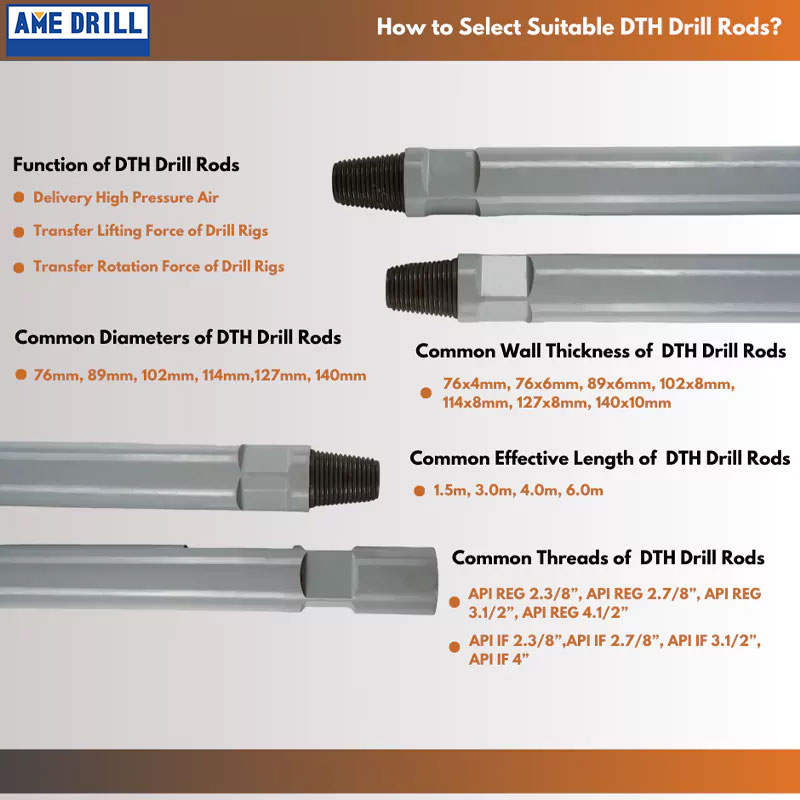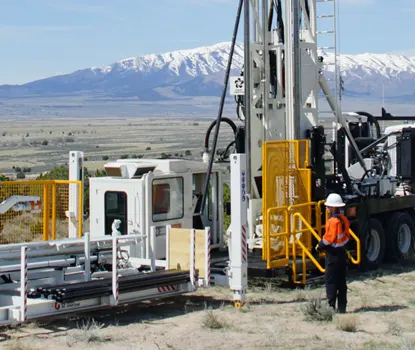DTH drill pipes/rods are essential tools in drilling operations and are widely used in mining, geotechnical engineering, hydraulic construction, and geological exploration.
1. Functions of DTH Drill Pipe/Rods:
Delivery High-Pressure Air: The DTH drill pipe/rod is responsible for transporting high-pressure air from the compressor to the DTH hammer, which, under pressure, drives the DTH drill bit to break rock.
Transfer Lifting Force: DTH drill pipes/rods effectively transmit the rotary power (torque) of the drill rigs to the DTH drill bit, driving it to rotate and cut through rock or soil.
Transfer Rotational Force: During drilling, DTH drill pipes/rods must withstand downward thrust from the drill rigs as well as reactionary forces caused by varying rock hardness.
Transport Flushing Media: The internal channel of DTH drill pipes/rods serves as a conduit for flushing media (such as water, air, or mud), which cools the drill bit, removes drill cuttings, and helps stabilize the borehole walls, enhancing drilling efficiency and quality.
2. Selection of DTH Drill Pipe/Rod Diameter
Common diameters include 76mm, 89mm, 102mm, 114mm, 127mm, and 140mm. The diameter of DTH drill pipes/rods affects the up-hole velocity and the efficiency of debris removal. A smaller diameter results in a larger annular space between the rod and the borehole walls, slowing the uphole velocity and thus affecting debris removal efficiency. Conversely, a larger diameter increases the upholevelocity and debris removal efficiency.
3. Selection of Wall Thickness for DTH Drill Pipes/Rods
Common wall thicknesses are 76x4mm, 76x6mm, 89x6mm, 102x8mm, 114x8mm, 127x8mm, and 140x10mm. Wall thickness directly impacts the strength and durability of DTH drill pipes/Rods. Thicker DTH drill pipes/rods have higher resistance to compression, tension, and torque, offering greater strength in handling complex geological conditions and hard rock layers, making them more suitable for shallow holes such as mining blast holes and shallow wells. However, their greater overall weight can lead to challenges in lifting and pressure issues in the drill rigs, making them less suitable for deep drilling.
Thin-walled DTH drill pipes/rods have lower torque, are lighter, are easier to handle and operate, and are suitable for deep drilling like water wells or geothermal wells. However, their lower compressive and tensile strengths make them susceptible to thinning walls and reduced strength in harder rock layers, leading to potential fractures or deformations; thus, they’re not recommended for high-strength drilling tasks.

4. Selection of DTH Drill Pipe/Rod Length
Common effective lengths include 1.5 m, 3.0 m, 4.0 m, and 6.0 m. The choice of DTH drill pipe/rod length mainly depends on operational space and the feed length of the drill rigs.
5. Selection of Threads for DTH Drill Pipes/Rods
Typical threads include API REG, such as API REG 2.3/8″, API REG 2.7/8″, API REG 3.1/2″, and API REG 4.1/2″; API IF threads are suitable for drilling deep water wells, e.g., API IF 2.3/8″, API IF 2.7/8″, API IF 3.1/2″, and API IF 4″.
6. DTH Drill Pipes/Rods with or without Wrench Flats
Sizes of DTH drill pipes/rods with wrench flats generally include 76 mm (57 mm, 65 mm), 89 mm (65 mm, 70 mm), 102 mm (83 mm, 75 mm), 114 mm (89 mm, 95 mm), 127 mm (89 mm), and 140 mm (114 mm). DTH drill pipes/rods with wrench flats can be manually changed using a wrench. Some drill rigs come with a built-in wrench that also allows for changing drill rods through the wrench flats. DTH drill pipes/rods without wrench flats are suitable for drill rigs equipped with an automatic rod carousel and are usually more expensive than those with wrench flats.
In practical drilling projects, it is necessary to select the appropriate DTH drill pipes/rods based on specific geological conditions and project requirements to achieve optimal construction results and economic benefits.


